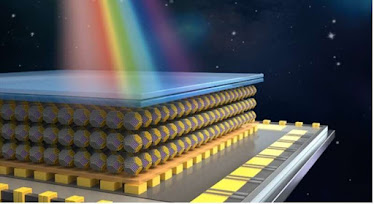A highly efficient colloidal quantum dot imager that operates at near-infrared wavelengths
Advances in the fields of robotics, autonomous driving and computer vision have increased the need for highly performing sensors that can reliably collect data in different environmental conditions. This includes imagers that can operate at near-infrared wavelengths (i.e., 0.7–1.4 µm), thus potentially collecting high resolution images in complex or unfavorable atmospheric conditions, such as in the presence of rain, fog and smoke.
Researchers at Huazhong University of Science and Technology (HUST), HiSilicon Optoelectronics Co. Limited, and Optical Valley Laboratory have recently developed a near-infrared colloidal quantum dot (CQD) imager. This highly efficient imager was presented in a paper published in Nature Electronics.
"Our group was founded at Wuhan National Laboratory for Optoelectronics, HUST in 2012 and continuously conducts research on CQD materials and devices with Associate Prof. Jianbing Zhang," Liang Gao, one of the researchers involved in the study, told TechXplore.
The recent work by Tang, Gao and their colleagues is the product of their collaboration with HiSilicon Optoelectronics Co. Limited, a renowned semiconductor company based in Shanghai, which was initiated in 2018. After they received funding from the company four years ago, the researchers have been focusing much of their research efforts on the development of a highly performing CQD imager.
"We have been working on our CQD imager for a long time," Jiang Tang, lead researcher for the study, told TechXplore. "I graduated from University of Toronto under the supervision of Prof. Edward Sargent, a pioneer of CQD infrared photodetectors and founder of the company InVisage. Our team at HUST's primary mission is to build a reliable near and short infrared imager with low costs."
Traditional near-infrared imagers are manufactured by heterogeneously integrating an epitaxially grown photodiode array and a silicon-based readout integrated circuit (ROIC). In contrast, the CQD imager introduced by Tang, Gao and their colleagues was created via the monolithic integration of a CQD photodiode array and a silicon-based ROIC.
CQDs are semiconductor crystals of nanometer sizes that contain surface ligands, which allow them to disperse in solvents. These crystals have favorable optical, electronic and physical properties that make them highly promising for the development of numerous technologies, including imagers, light emitting diodes and gas sensors.
"The CQD photodiode array transfers incident photons to electrons, and the silicon-based ROIC manipulates photo-generated electrons to output image signals," Gao explained. "The monolithic integration potentially enables smaller pixel size and higher resolution of CQD imager than heterogeneously integrated imager."
Most near-infrared imagers introduced in the past have high production costs, due to the complexity of the integration between infrared photodiodes and silicon-based circuits. The new imager's distinct design and fabrication process, on the other hand, makes it easier to realize, significantly cutting production costs.
"We directly deposited the sensing layer on top of the ROIC," Tang explained. "Our imager's unique advantage is the monolithic integration, which enables 12-inch wafer integration and limits production costs. We started from chemicals all the way to final chips, achieving a good imager."
This team of researchers was one of the first to demonstrate the integration of a top-illuminated CQD photodiode array with silicon-based ROIC technology. In initial tests, their photodiodes (i.e., photodetectors) exhibited a spectral range of 400–1,300 nm, room-temperature detectivity of 2.1 × 1012 Jones, −3 dB bandwidth of 140 kHz and linear dynamic range of over 100 dB.
Tang, Gao and his colleagues have so far used their newly developed photodiodes to create a large imager (640 x 512 pixels). They found that this imager attained a remarkable efficiency and spatial resolution.
"Our CQD imager shows the highest external quantum efficiency of 63% among the reported CQD imagers due to the developed device structure," Gao said. "The detailed presentation of our new CQD imager could serve as a reference for researchers and technicians specialized in emerging monolithically-integrated imager fields."
In the future, this new CQD imager could be used to collect high resolution images of veins, biological systems and matter particles. In their next studies, the researchers plan to develop CQD imagers with longer wavelengths and higher resolutions. In addition, they would like to try to integrate other functional sensors with silicon-based circuits using their monolithic integration strategy.
"In our future works, we will increase our imager's resolution (1K x 1K), its wavelength (1700 nm and beyond), and its stability (sustain 120C or even 150C to meet the stringent automobile application requirement), while also trying to create larger wafers (from 4 inch to 12 inch)," Tang added.
For more such news & interesting articles or how can it affect in your life subscribe to our newsletter.


Comments
Post a Comment